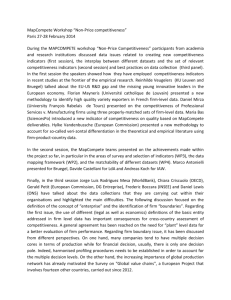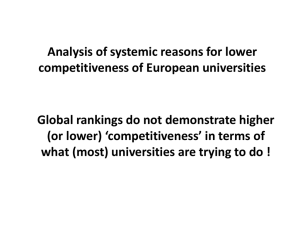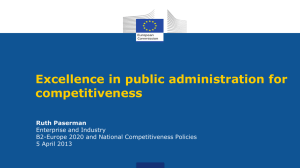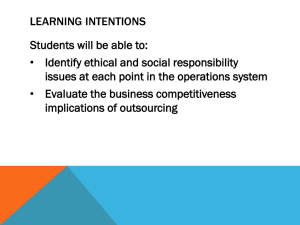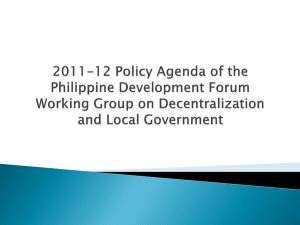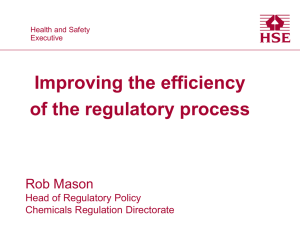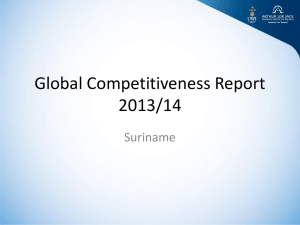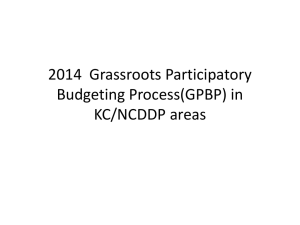BCC RegionalCompetitiveness - Philippines Development Forum
advertisement
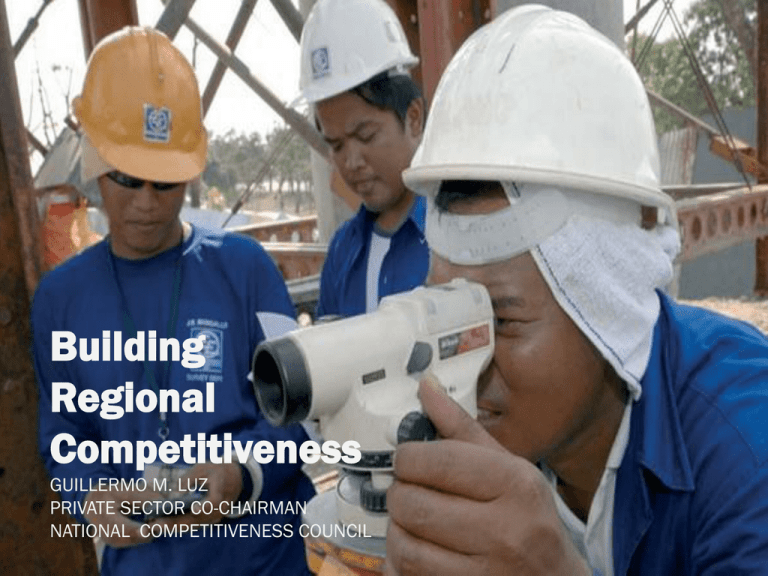
Building Regional Competitiveness GUILLERMO M. LUZ PRIVATE SECTOR CO-CHAIRMAN NATIONAL COMPETITIVENESS COUNCIL BUILDING REGIONAL / LOCAL COMPETITIVENESS Project Goal • Creation of regional or local competitiveness councils whose objectives are to strategically map out how to make their respective regions or communities more competitive vis-à-vis selected ASEAN cities. Specific Objectives • To encourage Regional Development Councils (RDCs) to organize their own Local Competitiveness Committees and work on the metrics to serve as a diagnostic tool for assessing their regional/local competitiveness. • To tap reputable universities per region/province for competitiveness data collection (research) and conduct of surveys. • To establish linkages with the various public and private key stakeholders and development partners in the regions/provinces for research, monitoring and evaluation. PROPOSED ACTIVITIES Data Collection – Competitiveness Indicators Capacity Building and Training Monitoring & Evaluation PROPOSED INDICATORS Assessing Local Economic Development/ Competitiveness Broad Indicator I: dynamism of local economy II: responsiveness of LGU to business needs III: Infrastructure IV: quality of life V: cost of doing business VI: human resources and training RDC - University Partner ( data collection) OVERALL RANKING & COMPETITIVENESS DRIVERS CITY OVERALL RANK DYNAMISM OF LOCAL ECONOMY COST OF DOING BUSINESS INFRASTRUCTURE HUMAN RESOURCES TRAINING RESPONSIVENESS OF LGU QUALITY OF LIFE METROPOLITAN GROWTH CENTERS Cebu City 1 1 2 1 1 2 2 Davao City 2 2 1 2 2 1 1 GROWTH CENTERS Cagayan de Oro City 1 1 3 2 3 3 3 Bacolod City 2 5 6 7 3 1 2 Zamboanga City 3 7 1 4 3 6 5 Olongapo City 4 10 4 3 3 8 1 General Santos City 5 9 7 1 7 9 3 Iloilo City 6 4 9 8 1 4 7 Mandaue City 7 2 5 6 7 7 9 Baguio City 8 6 10 10 2 2 6 Batangas City 9 8 2 9 7 5 8 Lapu-Lapu City 10 3 8 5 10 9 10 OVERALL RANKING & COMPETITIVENESS DRIVERS CITY OVERALL RANK DYNAMISM OF LOCAL ECONOMY COST OF DOING BUSINESS INFRASTRUCTURE HUMAN RESOURCES TRAINING RESPONSIVENESS OF LGU QUALITY OF LIFE EMERGENT CITIES Dagupan City 1 7 5 1 11 2 5 Tacloban City 2 8 13 10 1 1 5 San Fernando City 3 9 2 3 6 3 1 Ormoc City 4 5 3 4 11 6 5 Puerto Princesa City 5 2 17 6 11 9 3 Naga City 6 3 13 10 2 4 16 Pagadian City 7 17 1 8 6 7 13 Legaspi City 8 10 11 7 6 10 8 Tuguegarao City 9 4 7 13 6 5 11 Surigao City 10 15 9 9 11 8 9 Tagum City 11 11 8 2 11 12 17 Angeles City 12 1 15 12 11 15 14 Lucena City 13 6 6 17 2 11 9 Cotabato City 14 14 11 5 2 16 15 Iligan City 15 13 4 15 6 13 3 Butuan City 16 16 16 14 2 14 1 Santiago City 17 12 10 16 11 17 11 Indicators 1. Dynamism of Local Economy Total Population Total Income Per capita income Regional GDP Regional GDP per capita Regional GDP Growth Rate Indicators 2. Responsiveness of LGU to Business Needs Length of time to renew business permits (days) Cost of renewing business permits (% of annual revenue) Length of time to register property (days) Cost of registering property (% of value) Length of time to secure utility connection (days) Total time spent on administrative matters (i.e., tax and other payments), days per year Availability of investment incentives, local investment code Presence of Local Investment Promotion Office Presence of Business One-Stop Shop Indicators 3. Infrastructure Availability of 24 hr electricity Availability of 24 hr water service Quality of road network Number of telephone service providers Number of internet providers Quality of internet connections Total number of cars for hire Travel time to airport Travel time, access to nearest international airport Indicators 3. Infrastructure Travel time to seaport Travel time to nearest international seaport Indicators 4. Quality of Life Police to population ratio Monthly crime rate Doctor to population ratio Number of hospitals Number of hospital beds Number of high schools Number of colleges/universities Number of commercial banks Number of historical, tourism sites Indicators 4. Quality of Life Number of hotel rooms (4-star, 5-star) Number of daily domestic flights (to Manila, to Cebu) Number of daily international flights Indicators 5. Cost of Doing Business Electricity cost (P/kwh) Water rate (P/cu.m.) Fuel cost (premium, P/liter) Minimum wage (per day) Commercial space rental/lease rate, central business district (P/sqm/month) Commercial lot value (P/sqm) Industrial space rental / lease (P/sqm/month) Industrial lot value (P/sqm) Indicators Human Resources Total number of high school and college students Number of high school graduates per year Number of college, university graduates per year Number of graduates who earn Licenses, Certification Percentage of population with college degrees Number of technical-vocational schools Number of graduate schools Total number of employees Unemployment rate CAPACITY BUILDING AND TRAINING Customer Service Excellence for the LGUs/ BPLOs (c/o CIC) Aims to enhance LGUs/BPLO’s technical knowledge, professional attitude, and customer-orientation Local Investment Promotion (c/o BOI) Appreciation seminar for local executives, line-agencies and private sector organization representatives on their roles in investment promotion. It highlights the different investment promotion tools and strategies that can be used by the different localities to promote their area as an investment destination Urban Planning With populations growing and resources limited, it is important for LGUs and regions to properly undertake urban planning for optimal resource management MONITORING & EVALUATION Customer Feedback Surveys Quick-response, self-administered surveys covering one specific topic at a time. First survey covered BPLS and was conducted from Jan 10 – Feb 10. Field Monitoring In-depth studies to validate survey results and ask follow-up questions Baseline Data Collection Collection of basic data before and after programs are conducted in order to measure progress over time Enterprise Surveys Large-scale public opinion surveys conducted through face-to-face interviews BPLS-Field Monitoring Project (Bicol, pilot run) Objectives: • Validate results of the recently conducted BPLS in Bicol areas (Daraga, Tabaco, Guinobatan, Legaspi, Naga and Iriga) • Establish baseline data on BPLS and gather relevant information • Prepare completion report Implementation Date: March 12-23, 2012 Partners: NCC, academe, BCC, DTI-Bicol, RDC, development partner Project Mechanics: • NCC and partner universities/colleges conduct field monitoring interview with mayor, BPLO head of LGU and 3 businessmen from each identified LGU; • Preparation of reports for submission to NCC www.competitive.org.ph
